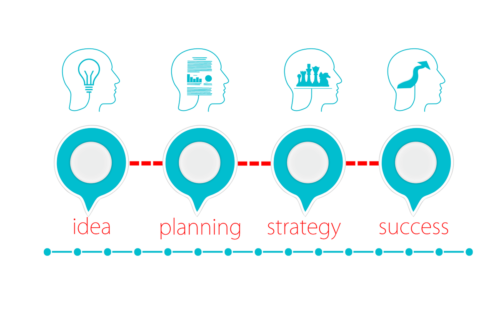The Straw Man Proposal for Problem Solving


Written and verified by the psychologist Valeria Sabater
The straw man proposal for problem solving is being increasingly used in the organizational sphere. It’s a mechanism to generate ideas and begins with a draft. It makes the most of the human and creative potential of work teams and, above all, of each member of a team.
Note that this isn’t your typical brainstorming method. The goal here is to shape a temporary solution to a problem while you come up with something better. The straw man proposal requires many varied ideas from the contributing group. Then, these proposals either merge or disappear at any given moment when it comes to rebuilding the original draft.
The United States Department of Defense first applied this technique in 1975. The air force needed an urgent action plan and devised this technique to find a quick and momentary response to that particular challenge. Later, the initial “straw man” would be replaced by “man of stone” and then by “iron man”.
The purpose was to achieve greater consistency and solidity to that strategy.
“Too often we give our children answers to remember rather than problems to solve.”
-Roger Lewin-

The straw man proposal is a simple collaborative strategy
The straw man proposal has become quite popular in recent years thanks to the well-known consulting firm McKinsey & Company. This global organization is basically in charge of solving problems. It serves large companies, institutions, and even governments around the world.
The fact that they use this strategy as a mechanism to respond to the challenges they face is the first clue of its usefulness. For one, it’s easy to do. Also, it promotes the synergy of all the members of the organization. In addition, it promotes the step-by-step construction of a more sophisticated and effective action strategy.
The straw man proposal for problem solving
The straw man proposal is a useful and effective problem solving tool for any group setting. Its purpose is to build, shape, and design a preliminary action plan in the form of a draft. Then, they redefine this draft until finding a more effective response. Thus, it rises from straw man to iron man.
The advantages of this brainstorming mechanism
As we mentioned at the beginning, this article isn’t discussing classic brainstorming techniques. In this case, you start from a draft, from an already designed base that constitutes the straw man. Later, there’s a meeting in which each member contributes their ideas, criticisms, and proposals, but always starting with the draft.
Some of its advantages are:
- It’s a problem-solving approach that brings work teams together.
- Also, it allows each member to contribute their abilities and creativity.
- It promotes feedback and better hypotheses by breaking down those that don’t work.
- Finally, it improves the brainstorming process by starting from a previous plan (the draft or straw man).
This proposal keeps the group from getting stuck. They don’t look for perfection right away but advance in phases: from straw man to stone man to steel man to…

The straw man proposal
This proposal requires the following of specific steps. Adjusting to them will allow the group to know what to expect and how to proceed. Also, what each member must know is everyone must argue and refute the reasoning behind any proposal.
All perspectives are then taken into account to finally build a temporary feasible and logical strategy. Later, the group meets again in order to continue to fine-tune the action plan.
The steps
- Creating the draft proposal. Each member of the group will individually create their own straw man proposal or approach strategy.
- Presenting the conceptual proposals. The second step is the submission of all the drafts. Each member presents their action proposal to the rest of the group. Then, they all analyze, debate, and demolish any ideas that aren’t useful and keep those that are.
- Discussion. After recording all interesting proposals of each member, the group proceeds to discuss every idea in order to screen, eliminate, or accept any parts that may be useful. They build a straw man with each one of these elements.
- Conclusions. The straw man proposal is already solid at this stage but parts of it continue to be demolished and added. Thus, the group reaches more or less valid conclusions progressively.
- Final decision. The straw man is already built at this point. The group reached a final (but temporary) decision they can apply and which all members agree on. However, as we mentioned above, the goal is to further refine that strategy to create a more solid, safe, and effective action plan.
To conclude, as you can see, it’s a rather interesting work dynamic that integrates every member of the organization in a problem-solving task. It’s interesting, simple, and many teams use it nowadays.
The straw man proposal for problem solving is being increasingly used in the organizational sphere. It’s a mechanism to generate ideas and begins with a draft. It makes the most of the human and creative potential of work teams and, above all, of each member of a team.
Note that this isn’t your typical brainstorming method. The goal here is to shape a temporary solution to a problem while you come up with something better. The straw man proposal requires many varied ideas from the contributing group. Then, these proposals either merge or disappear at any given moment when it comes to rebuilding the original draft.
The United States Department of Defense first applied this technique in 1975. The air force needed an urgent action plan and devised this technique to find a quick and momentary response to that particular challenge. Later, the initial “straw man” would be replaced by “man of stone” and then by “iron man”.
The purpose was to achieve greater consistency and solidity to that strategy.
“Too often we give our children answers to remember rather than problems to solve.”
-Roger Lewin-

The straw man proposal is a simple collaborative strategy
The straw man proposal has become quite popular in recent years thanks to the well-known consulting firm McKinsey & Company. This global organization is basically in charge of solving problems. It serves large companies, institutions, and even governments around the world.
The fact that they use this strategy as a mechanism to respond to the challenges they face is the first clue of its usefulness. For one, it’s easy to do. Also, it promotes the synergy of all the members of the organization. In addition, it promotes the step-by-step construction of a more sophisticated and effective action strategy.
The straw man proposal for problem solving
The straw man proposal is a useful and effective problem solving tool for any group setting. Its purpose is to build, shape, and design a preliminary action plan in the form of a draft. Then, they redefine this draft until finding a more effective response. Thus, it rises from straw man to iron man.
The advantages of this brainstorming mechanism
As we mentioned at the beginning, this article isn’t discussing classic brainstorming techniques. In this case, you start from a draft, from an already designed base that constitutes the straw man. Later, there’s a meeting in which each member contributes their ideas, criticisms, and proposals, but always starting with the draft.
Some of its advantages are:
- It’s a problem-solving approach that brings work teams together.
- Also, it allows each member to contribute their abilities and creativity.
- It promotes feedback and better hypotheses by breaking down those that don’t work.
- Finally, it improves the brainstorming process by starting from a previous plan (the draft or straw man).
This proposal keeps the group from getting stuck. They don’t look for perfection right away but advance in phases: from straw man to stone man to steel man to…

The straw man proposal
This proposal requires the following of specific steps. Adjusting to them will allow the group to know what to expect and how to proceed. Also, what each member must know is everyone must argue and refute the reasoning behind any proposal.
All perspectives are then taken into account to finally build a temporary feasible and logical strategy. Later, the group meets again in order to continue to fine-tune the action plan.
The steps
- Creating the draft proposal. Each member of the group will individually create their own straw man proposal or approach strategy.
- Presenting the conceptual proposals. The second step is the submission of all the drafts. Each member presents their action proposal to the rest of the group. Then, they all analyze, debate, and demolish any ideas that aren’t useful and keep those that are.
- Discussion. After recording all interesting proposals of each member, the group proceeds to discuss every idea in order to screen, eliminate, or accept any parts that may be useful. They build a straw man with each one of these elements.
- Conclusions. The straw man proposal is already solid at this stage but parts of it continue to be demolished and added. Thus, the group reaches more or less valid conclusions progressively.
- Final decision. The straw man is already built at this point. The group reached a final (but temporary) decision they can apply and which all members agree on. However, as we mentioned above, the goal is to further refine that strategy to create a more solid, safe, and effective action plan.
To conclude, as you can see, it’s a rather interesting work dynamic that integrates every member of the organization in a problem-solving task. It’s interesting, simple, and many teams use it nowadays.
This text is provided for informational purposes only and does not replace consultation with a professional. If in doubt, consult your specialist.







